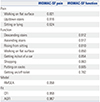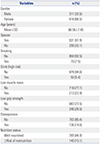1. Xie F, Kovic B, Jin X, He X, Wang M, Silvestre C. Economic and humanistic burden of osteoarthritis: a systematic review of large sample studies. Pharmacoeconomics. 2016; 34:1087–1100.


2. Beaudart C, Biver E, Bruyère O, Cooper C, Al-Daghri N, Reginster JY, et al. Quality of life assessment in musculo-skeletal health. Aging Clin Exp Res. 2018; 30:413–418.


3. Yoo JI, Park JS, Kim RB, Seo AR, Park YJ, Kim MJ, et al. WHO disability assessment schedule 2.0 is related to upper and lower extremity disease-specific quality of life. Qual Life Res. 2018; 27:2243–2250.


4. Ostendorf M, van Stel HF, Buskens E, Schrijvers AJ, Marting LN, Verbout AJ, et al. Patient-reported outcome in total hip replacement. A comparison of five instruments of health status. J Bone Joint Surg Br. 2004; 86:801–808.

5. SooHoo NF, McDonald AP, Seiler JG 3rd, McGillivary GR. Evaluation of the construct validity of the DASH questionnaire by correlation to the SF-36. J Hand Surg Am. 2002; 27:537–541.


6. Bellamy N, Buchanan WW, Goldsmith CH, Campbell J, Stitt LW. Validation study of WOMAC: a health status instrument for measuring clinically important patient relevant outcomes to antirheumatic drug therapy in patients with osteoarthritis of the hip or knee. J Rheumatol. 1988; 15:1833–1840.

7. Burchell B, Marsh C. The effect of questionnaire length on survey response. Qual Quant. 1992; 26:233–244.

8. Herzog AR, Bachman JG. “Effects of questionnaire length on response quality”. Public Opin Q. 1981; 45:549–559.

9. Kalantar JS, Talley NJ. The effects of lottery incentive and length of questionnaire on health survey response rates: a randomized study. J Clin Epidemiol. 1999; 52:1117–1122.


10. Choi YS, Kim MJ, Lee GY, Seo YM, Seo AR, Kim B, et al. The association between frailty and disability among the elderly in rural areas of Korea. Int J Environ Res Public Health. 2019; 16:E2481.

11. Bae SC, Lee HS, Yun HR, Kim TH, Yoo DH, Kim SY. Cross-cultural adaptation and validation of Korean Western Ontario and McMaster Universities (WOMAC) and Lequesne osteoarthritis indices for clinical research. Osteoarthritis Cartilage. 2001; 9:746–750.


12. Bilbao A, Quintana JM, Escobar A, Las Hayas C, Orive M. Validation of a proposed WOMAC short form for patients with hip osteoarthritis. Health Qual Life Outcomes. 2011; 9:75.

13. Davis AM, Badley EM, Beaton DE, Kopec J, Wright JG, Young NL, et al. Rasch analysis of the Western Ontario McMaster (WOMAC) Osteoarthritis Index: results from community and arthroplasty samples. J Clin Epidemiol. 2003; 56:1076–1083.


15. Kutlay S, Küçükdeveci AA, Elhan AH, Oztuna D, Koç N, Tennant A. Validation of the World Health Organization disability assessment schedule II (WHODAS-II) in patients with osteoarthritis. Rheumatol Int. 2011; 31:339–346.


16. Kim JM, Stewart R, Glozier N, Prince M, Kim SW, Yang SJ, et al. Physical health, depression and cognitive function as correlates of disability in an older Korean population. Int J Geriatr Psychiatry. 2005; 20:160–167.


17. Shinkai S, Watanabe N, Yoshida H, Fujiwara Y, Amano H, Lee S, et al. [Research on screening for frailty: development of “the Kaigo-Yobo Checklist”]. Nihon Koshu Eisei Zasshi. 2010; 57:345–354.

18. Chen LK, Liu LK, Woo J, Assantachai P, Auyeung TW, Bahyah KS, et al. Sarcopenia in Asia: consensus report of the Asian Working Group for Sarcopenia. J Am Med Dir Assoc. 2014; 15:95–101.


21. Yang KG, Raijmakers NJ, Verbout AJ, Dhert WJ, Saris DB. Validation of the short-form WOMAC function scale for the evaluation of osteoarthritis of the knee. J Bone Joint Surg Br. 2007; 89:50–56.

22. Batista-Foguet JM, Coenders G, Alonso J. [Confirmatory factor analysis. Its role on the validation of health related questionnaires]. Med Clin (Barc). 2004; 122 Suppl 1:21–27.

23. MacKay C, Clements N, Wong R, Davis AM. A systematic review of estimates of the minimal clinically important difference and patient acceptable symptom state of the Western Ontario and Mc-Master Universities Osteoarthritis Index in patients who underwent total hip and total knee replacement. Osteoarthritis Cartilage. 2019; 27:1408–1419.


24. Silva C, Coleta I, Silva AG, Amaro A, Alvarelhão J, Queirós A, et al. Adaptation and validation of WHODAS 2.0 in patients with musculoskeletal pain. Rev Saude Publica. 2013; 47:752–758.

25. Hwang HS, Kwon IS, Park BJ, Cho B, Yoon JL, Won CW. The validity and reliability of Korean frailty index. J Korean Geriatr Soc. 2010; 14:191–202.






 PDF
PDF ePub
ePub Citation
Citation Print
Print







 XML Download
XML Download